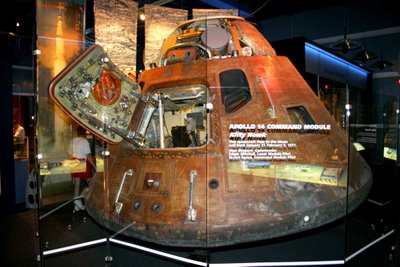
This is Launch Complex 34. It is a somber place today, a place for reflection on the hazards of spaceflight. This is the pedestal on which a Saturn IB rocket would sit before launch. A gantry rolled in and out on the tracks in front and behind from this point of view and would roll to the left. In the background are two flame deflectors that would be rolled under the pedestal to deflect flame to the sides of the pad.
In the early evening of January 27, 1967, 3 men sat inside the capsule of a Block I Apollo spacecraft sitting on top of a Saturn IB booster resting on this launch pad, taking part in a countdown test in preparation for their launch about a month later on the very first manned Apollo spaceflight. The crew of Apollo 1 were Commander Gus Grissom, the 2nd American in space; Ed White, the first American to walk in space on Gemini 4; and rookie astronaut Roger Chaffee. They sat in spacecraft CM-012 atop Saturn IB rocket number 204. The hatch was sealed and the spacecraft pressurized to about 16.7 psi of pure oxygen. Their simulated countdown was halted at T-10 minutes while issues with the communications links were being worked out and the crew had been in the spacecraft on their backs for several hours. They must have been bored with not much going on and maybe a little tired of lying on their backs for so long, as well as frustrated by the nagging problems, but that was the life of a NASA astronaut.
At 18:31 local time, all that changed and our innnocence in manned spaceflight was lost in an entirely unexpected way. Somewhere below and to the left of Grissoms couch (from the hatch, Grissom sat on the left, White in the middle, Chaffee on the right), a spark probably from some chaffed wiring ignited a fire. The spacecraft was designed with fire safety in mind, but no one had considered the affects of pure high pressure oxygen. At 16.7psi of pure oxygen, almost anything is flammable and a lot of material in the spacecraft provided ample fuel for the fire. The crew quickly noticed the fire and called out over the comm channel about the fire, almost calmly at first. The fire grew rapidly and probably by the time they had noticed it, the pressure inside the spacecraft rose even more from the heat of the fire, sealing their fate. The hatch was designed to be held in place partly by the internal pressure of the spacecraft and with that pressure much higher than normal and rising due to the fire, it quickly became impossible even for a very athletic Ed White to pull the hatch free to make their escape. Even with no emergency, it normally took 90 seconds to remove the hatch. The 3 astronauts were trapped inside their burning spacecraft. The fumes quickly overcame them and probably in less than about 30 seconds, they fell unconscious as the smoke and heat grew. Because of the heat and smoke, it took more than 5 minutes for the pad crew to get the hatch open and by then it was too late. The crew of Apollo 1 were dead.
The sacrafice made by Grissom, White, and Chaffee undoubtably made the Apollo spacecraft into the remarkably successful vehicle it turned out to be and probably saved the lives of future astronauts and it was in their memory that we landed 12 men on the Moon during Apollo. Today, this launch complex sits abandoned as a monument to that tragic day and to the memory of those 3 brave astronauts. There is a small flag and plaque on the side of this pedestal and stenciled into the oceanside wall on the left in this image are the words "Abandon in Place" - a standard term used to indicate to leave this facility as is. It slowly deteriorates today in the Florida weather, but it is worth pausing here and remembering all fallen astronauts in our conquest and exploration of space.
Not long before his death, Gus Grissom said: "If we die, we want people to accept it. We're in a risky business, and we hope that if anything happens to us it will not delay the program. The conquest of space is worth the risk of life."
This image was taken with the kit lens at 18mm focal length on my 20D. The exposure was 1/640 seconds at f/11, ISO 400.





























